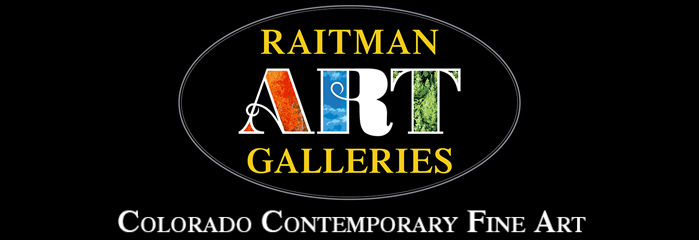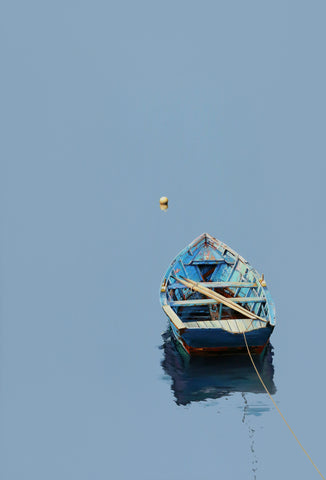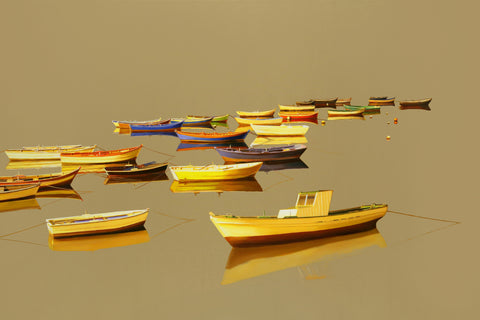Roger Hayden Johnson: Inspiration Behind the Paintings August 16 2020, 0 Comments
A HARD LIFE AT SEA
I love to paint small wooden rowboats, mainly dinghies and skiffs, and I love to travel in search of these evocative objects. My favorites are humble and quite simple. Their construction and decoration is practical and straightforward - not exotic in any way. They do not look foreign. They do not look Spanish, Italian, French, Sicilian, Corsican, Croatian, or Maltese. They are functional. If they appear aesthetically pleasing or compelling, it seems largely by accident or age rather than human intent. I especially appreciate badly worn, weathered, often broken, and crudely repaired, boats. The multiple repairs and repaints can seem charmingly improvised rather than carefully considered and executed. I feel that roughly used and badly tended boats invite contemplation of time and nature. We can read the effects of a hard life on the sea in their multiple layers of chipped and sun-bleached paint, worn edges, scraped sides, and broken trim and oarlocks. We can also trace the hand of man in a near narrative of creation, use, and repair in these often beautiful and thought-provoking objects.
SANTIAGO DE COMPOSTELA
Although I have found the rowboats I love to paint (dinghies, dories, tenders, and skiffs) in harbors all over the U.S. and Europe, my favorites come from harbors on the Atlantic coast of northwestern Spain. My wife and I spend several weeks there each spring visiting the many fishing villages near Santiago de Compostela*. Santiago is the destination of the famous pilgrimage route – the Road or Camino to Santiago - or simply “The Way." The Camino was just one branch of a network of pilgrimage routes to Santiago that developed throughout Europe during the early Middle Ages. Christian pilgrims would walk for weeks or even months to visit the tomb of Saint James the Elder in the crypt beneath the Cathedral. According to legend, the body of Saint James (in a stone boat?) had miraculously washed up on the shore near the city of Santiago. James had preached the Gospel on the Iberian Peninsula but had later been martyred by decapitation in Jerusalem. The decision to inter the body of the saint beneath the cathedral was an outrageously successful marketing ploy. Christians came by the thousands. At the time, the only other similarly important pilgrimage sites (the visitation of which could ease the pilgrim’s entry into heaven) were in Rome and Jerusalem. Both were much farther away from Central Europe and their routes were much more dangerous.
*Santiago de Compostela translates as “Saint James (Iago is James in Galician) of the Field of Stars.” The “Field of Stars” refers to the Milky Way, which seems to sweep west across the night sky of northern Spain toward the tomb of Saint James the Elder, one of the twelve apostles of Christ.
THE COAST OF DEATH
Walking medieval pilgrimage routes to Santiago de Compostela is still very popular today – especially its most famous branch, the Camino de Santiago or “the Way,” which begins at St. Jean Pied de Port in the southwest corner of France. When spending time in Santiago de Compostela, my wife and I are often asked if we have “done” the Camino. I reply that we have – “but by air.” We do enjoy meeting and speaking with the actual pilgrims in Santiago, who often explain that they have walked for spiritual rather than religious reasons. Although often bandaged and limping, most pilgrims seem to have benefited from the weeks of quiet self-reflection* and are amazingly open, honest, and friendly. They are certainly proud of their accomplishment and in the mood to celebrate. In the evenings my wife and I are happy to share in their celebrations over tapas or seafood and white wine. During the days, my wife polishes her Spanish in intensive language classes. I explore the many fishing harbors along the Atlantic coast nearby. I am looking for simple wooden rowboats that show the effects of their harsh, unforgiving life on the sea. Because this coast was particularly treacherous, it came to be known as La Costa da Morte – the “Coast of Death.” Certain villages along the coast even developed the reputation for building fires along the coast to lure ships to ruin on the rocks where their cargoes could be claimed as salvage.
*The “Way” begins in France and takes 30 to 35 days of walking about 15 miles a day.
THE END OF THE EARTH
My favorite harbor for finding old, weathered boats is on the Costa da Morta in northwestern Spain at Finisterre (“End of the Earth”). This large and deep harbor is on a small peninsula or cape extending west into the Atlantic near Santiago de Compostela. It was called Finisterre (or Fisterra in Galician) because it was thought to have been the actual end of the Earth during the Middle Ages, before the discovery of the New World. (Later it was determined that the actual furthermost western extension of Europe was in Portugal). A walk to Finisterre was a traditional extension to the famous Camino of Santiago pilgrimage route. After visiting the tomb of Saint James the Elder (Santiago) in the crypt beneath the Cathedral in the city of Santiago de Compostela, pilgrims would often walk three or four days farther to burn the clothes that they had worn during their often weeks-long pilgrimage upon the sand at the harbor at Finisterre. They would put on new clothes as a symbol of spiritual rebirth. Many of the skiffs and dinghies that I paint are from Finisterre or smaller harbors nearby.




